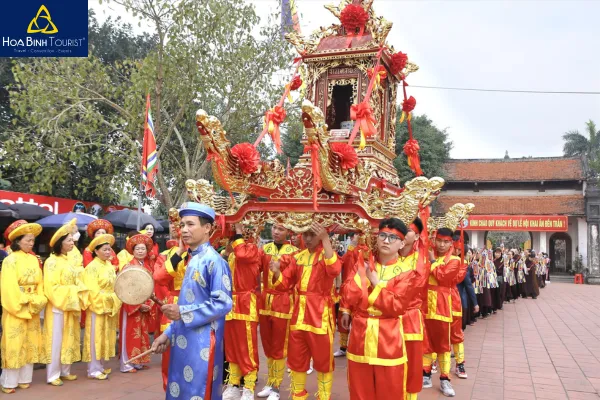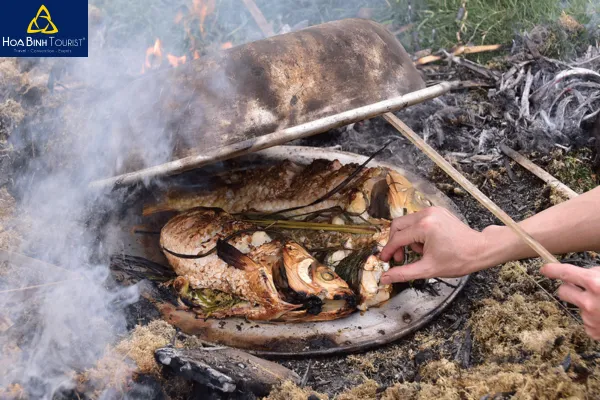Nam Định, a land of remarkable people and rich history, is not only famous for its traditional craft villages and white salt fields but also the location of Trần Temple, a historical and cultural relic of immense significance. Visiting Trần Temple in Nam Định is more than just exploring an ancient architectural work; it’s an opportunity to immerse yourself in a spiritual and cultural space, learn about the nation’s heroic history, and experience unique traditional festivals. Join us as we uncover the unique beauty and profound spiritual values that Trần Temple in Nam Định offers in the article below.
Discovering Trần Temple Nam Định: From History to Unique Architecture
1. History of Trần Temple: Traces of the Second Capital of Đại Việt
Trần Temple is situated on Trần Thừa Street, Lộc Vượng Ward, Nam Định City, Nam Định Province, in the land that was once the heart of Thiên Trường Prefecture, known as the “second capital” of the Trần Dynasty, after Thăng Long (Hanoi). This place was formerly the Thái miếu (Royal Ancestral Temple), where ancestors and Trần kings were worshiped before being built into a temple in 1695.
Thiên Trường Prefecture held a particularly strategic position in the history of the Trần Dynasty. In 1258, when the Mongol army invaded, King Trần Thái Tông decided to withdraw troops from Thăng Long to Thiên Trường Prefecture to preserve forces, implementing the “empty garden, empty house” strategy. Here, on the 14th day of the first lunar month, the king held a grand banquet, rewarding and bestowing titles upon meritorious generals and soldiers, and conducting the seal opening ceremony at the beginning of the year, praying for national peace and prosperity. This event became the precedent for the Trần Temple seal opening ceremony today, a ritual imbued with cultural and spiritual values.

Through historical ups and downs, Trần Temple still stands majestically, a testament to a glorious dynasty with resounding victories, especially the three times defeating the Mongol invaders. The temple is not only a place to worship the Trần kings but also a symbol of patriotism, solidarity, and the indomitable spirit of the Vietnamese people.
2. Unique Architecture of Trần Temple: A Harmonious Blend of Spirituality and Art
The architectural complex of Trần Temple includes three main structures: Thiên Trường Temple (Upper Temple), Cố Trạch Temple (Lower Temple), and Trùng Hoa Temple. Each temple possesses its own unique architectural beauty, yet they harmonize within the overall complex, reflecting the talent and sophistication of the ancients.
Thiên Trường Temple: As the main and largest temple, it was built on the foundation of the old Thái miếu. Thiên Trường Temple is prominent for its “nội công ngoại quốc” architecture (inner court, outer border), comprising 9 buildings and 31 rooms, made from precious ironwood, with tile roofs and Bát Tràng brick floors. The front hall, middle hall, main chamber, incense burning house, left and right corridors, and east-west rows are arranged symmetrically, creating a majestic and solemn atmosphere. Notably, the stone pedestals supporting the columns in the front hall are carved with intricate lotus petal patterns, reminiscent of the palace architecture of the Trần Dynasty.
Cố Trạch Temple: Located to the east of the relic site, it was built in 1895 on the old house foundation of Hưng Đạo Vương Trần Quốc Tuấn (National Hero Trần Quốc Tuấn). Cố Trạch Temple has a more modest architecture compared to Thiên Trường Temple but still retains its ancient and solemn features. The temple is dedicated to Hưng Đạo Vương, his family, and generals who made great contributions in the resistance against the Mongol invaders.
Trùng Hoa Temple: Located to the left of Thiên Trường Temple, it was built in 2000 on the foundation of the former Trùng Hoa Palace, where Trần kings often consulted with the retired emperor. A special feature of Trùng Hoa Temple is the system of 14 bronze statues of Trần kings placed in the middle and main chambers, recreating the image of the wise rulers of the Trần Dynasty.
A common feature in the architecture of all three temples is the harmonious combination of spiritual and artistic elements. The structures all use traditional materials, with meticulously carved lines, expressing reverence for the ancestors and the cultural and historical values of the nation.
Trần Temple Festival Nam Định: Immerse Yourself in a Unique Spiritual and Cultural Space
A trip to Trần Temple in Nam Định is incomplete without participating in traditional festivals, especially the Khai Ấn (Seal Opening) Festival and the August lunar month festival. These are opportunities for visitors to experience solemn rituals, immerse themselves in the bustling festival atmosphere, and learn more about the culture and beliefs of the people of Nam Định.
1. Khai Ấn (Seal Opening) Festival at Trần Temple: New Year Blessing Ritual
The Khai Ấn Festival at Trần Temple takes place on the night of the 14th and the 15th day of the first lunar month annually. This is one of the most important festivals of Nam Định, attracting tens of thousands of pilgrims from all over. The Khai Ấn Festival reenacts the seal granting ritual of the ancient Trần kings, signifying prayers for national peace, prosperity, and blessings for everyone in the new year.
The official ceremony begins at Tý hour (1:00 AM) on the 15th day of the first lunar month with activities of procession of the seal carriage from Cố Trạch Temple to Thiên Trường Temple, followed by the seal opening ceremony at Thiên Trường Temple. The opened seal is the seal of the Trần Dynasty, inscribed with four characters “Tích phúc vô cương,” meaning to educate descendants about accumulating virtue and doing good to enjoy blessings.

After the seal opening ceremony, people and visitors are given seals to pray for luck, fortune, career advancement, and peace in the new year. Many believe that possessing a seal from Trần Temple will bring good fortune and success in life.
In addition to the Khai Ấn Festival, the festival also includes many other traditional cultural activities such as:
- Ngọc Lộ Carriage Procession: Procession of the Đức Phật Hoàng Trần Nhân Tông’s (King-Buddha Trần Nhân Tông) incense burner from Phổ Minh Pagoda to Trần Temple, expressing respect for ancestors and Buddhist teachings.
- Water and Fish Worshiping Ritual: Reenacting the water ancestor worshiping custom of the Trần clan, praying for favorable weather and bountiful harvests.
- Tết Thượng Nguyên (First Full Moon Festival) Ceremony on the fifteenth day of the first lunar month: Praying for peace and blessings for oneself and family.
2. August Festival at Trần Temple: Recreating the Cultural Space of the Trần Dynasty
The August Festival at Trần Temple takes place from the 15th to the 20th day of the eighth lunar month, commemorating the merits of the Trần kings and recreating the unique cultural features of this dynasty. The festival is organized more solemnly in even-numbered years.
The ceremonial part includes processions and solemn rituals, with the participation of procession groups from surrounding communal houses and temples. In particular, the incense offering ceremony is performed by 14 virgin girls, carrying 14 trays of flowers offered to the 14 royal thrones, reenacting the ancient court scene.

The festival part features many rich and attractive folk cultural activities such as:
- Chicken fighting, martial arts performances: Demonstrating the martial spirit of the nation.
- Wrestling, lion dance: Traditional folk games, bringing a joyful and bustling atmosphere.
- Chinese chess, walking on a bamboo bridge, hát văn (spiritual singing), múa bài bông (flower dance): Unique cultural and artistic activities, imbued with national identity.
The August Festival at Trần Temple is not only an opportunity for entertainment but also a chance for visitors to learn about the history, culture, and people of Nam Định, while feeling the sacred and solemn atmosphere of a traditional festival.
Travel Tips for Trần Temple Nam Định: Preparing for a Complete Exploration
1. Ideal Time to Visit Trần Temple
The best time to visit Trần Temple in Nam Định is in the spring, especially during the Khai Ấn Festival in the first lunar month or in the eighth lunar month to participate in the August festival. However, if you want to avoid crowds, you can visit the temple at other times of the year.
2. Transportation to Trần Temple
Trần Temple is about 85km from Hanoi, and visitors can travel by various means:
- Coach: There are many coach routes from Hanoi to Nam Định, departing from Giáp Bát and Nước Ngầm bus stations.
- Private car, motorbike: Travel along the Pháp Vân – Cầu Giẽ highway, then follow National Highway 1A or National Highway 10 to Nam Định.
- Airplane: For visitors from the South or Central regions, you can fly to Nội Bài Airport (Hanoi), then travel by coach or taxi to Nam Định.
3. Accommodation When Visiting Trần Temple
In Nam Định city, there are many hotels and guesthouses with diverse price ranges, suitable for the needs of all visitors. You can choose hotels near the Trần Temple area for convenient sightseeing and festival participation.
4. Unique Cuisine Around Trần Temple
Visiting Trần Temple in Nam Định is also an opportunity for you to enjoy famous specialties of Nam Định:
- Phở bò Nam Định (Nam Định beef noodle soup): Characteristic flavor of beef noodle soup, rich broth, and fresh beef.
- Cá nướng úp chậu (Grilled fish in a pot): Unique dish, delicious flavor, imbued with local identity.
- Bánh cuốn làng Kênh (Kênh village steamed rice rolls): Thin steamed rice rolls, fragrant wood ear mushroom and minced meat filling, served with sweet and sour dipping sauce.
- Xôi xíu (Savory sticky rice with pork): Familiar breakfast sticky rice dish, fragrant sticky rice, rich xá xíu (Cantonese BBQ pork).
- Nem nắm Giao Thủy (Giao Thủy fermented pork roll): Famous fermented pork roll, suitable for buying as a gift.

5. Travel Costs for Trần Temple
The cost of traveling to Trần Temple in Nam Định is quite reasonable. The entrance ticket to the temple is free. The main costs include transportation, food, accommodation, and souvenir shopping. If you choose a package tour, the cost will range from 800,000 to 1,500,000 VND per person, depending on the duration and services.
6. Important Notes When Visiting Trần Temple
- Dress code: Choose polite and discreet clothing when visiting temples and pagodas.
- Security: Pay attention to personal belongings, especially during crowded festival seasons.
- Offerings: Prepare appropriate offerings if you intend to make offerings at the temple.
- Cultural etiquette: Maintain a respectful and civilized attitude when visiting and worshiping at the temple.
Conclusion
Traveling to Trần Temple in Nam Định is a meaningful journey, helping you explore the profound historical, cultural, and spiritual values of the nation. From ancient architecture and traditional festivals to unique cuisine, Trần Temple in Nam Định promises to bring visitors unforgettable experiences. Plan your trip to Trần Temple in Nam Định today to discover the beauty and spiritual values that this place offers.